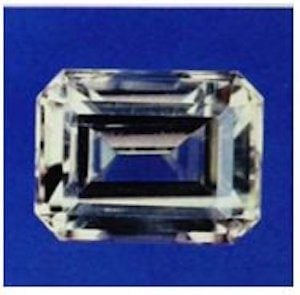Diaspore Value, Price, and Jewelry Information
Diaspore is hard enough to make a durable jewelry stone, but the typical light brownish color is not easy to sell. Despite the large Turkish material, this is a very rare gemstone indeed.
Diaspore is hard enough to make a durable jewelry stone, but the typical light brownish color is not easy to sell. Despite the large Turkish material, this is a very rare gemstone indeed.
Start an IGS Membership today
for full access to our price guide (updated monthly).Diaspore Value
DIASPOREDimorph of Boehmite.
Optics: a = 1.702; β = 1.722; γ = 1.750.
Biaxial (+). 2V = 85°.
Occurrence: In metamorphosed limestones, chloritic schists, and altered igneous rocks. Also in bauxite deposits.
Mamaris, Yagatan, Mugla Province, Turkey: gemmy, pale brown crystals of very large size.
Chester, Massachusetts: with corundum in emery deposit; some fragments cuttable.
Chester County Pennsylvania: fine transparent crystals up to 2 inches long and ¼ inch thick, colorless to brown; some cuttable. Hungary: good crystals.
Postmasburg district, South Africa: manganiferous variety.
Cornwall, England; Greenland; Norway; Sweden; France; Switzerland; Germany; Greece; USSR; Japan; China
Comments: Diaspore is hard enough to make a durable jewelry stone, but the typical light brownish color is not easy to sell. Despite the large Turkish material, this is a very rare gemstone indeed.
Name: From the Greek diaspeirein, meaning to scatter, because it falls apart in the hot flame of a blowpipe.
Joel E. Arem, Ph.D., FGA
Dr. Joel E. Arem has more than 60 years of experience in the world of gems and minerals. After obtaining his Ph.D. in Mineralogy from Harvard University, he has published numerous books that are still among the most widely used references and guidebooks on crystals, gems and minerals in the world.
Co-founder and President of numerous organizations, Dr. Arem has enjoyed a lifelong career in mineralogy and gemology. He has been a Smithsonian scientist and Curator, a consultant to many well-known companies and institutions, and a prolific author and speaker. Although his main activities have been as a gem cutter and dealer, his focus has always been education. joelarem.com
Related Articles
An Introduction to Turkey’s Gemstones
Black Diamond Value, Price, and Jewelry Information
Chameleon Diamond Value, Price, and Jewelry Information
Gray Diamond Value, Price, and Jewelry Information
Latest Articles
Morganite Buying Guide
How Do Amethysts Form?
Rhodizite Value, Price, and Jewelry Information
Pearl Treatments and Enhancements
Never Stop Learning
When you join the IGS community, you get trusted diamond & gemstone information when you need it.
Get Gemology Insights
Get started with the International Gem Society’s free guide to gemstone identification. Join our weekly newsletter & get a free copy of the Gem ID Checklist!
